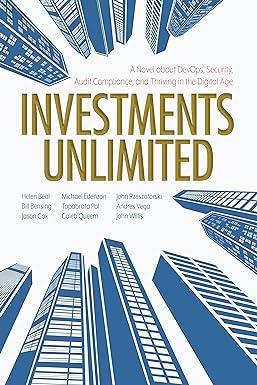Question
1) A ten-year T-bond has an eight percent coupon, and an eight-year T-bond has a ten percent coupon. These bonds are not callable and both
1) A ten-year T-bond has an eight percent coupon, and an eight-year T-bond has a ten percent coupon. These bonds are not callable and both have the same risk. If the yield to maturity (required rate of return) of both bonds increases by the same amount, which of the following statements would be CORRECT?
a) The prices of both bonds will decrease by the same amount.
b) The prices of both bonds would increase by the same amount.
c) Both bonds would decline in price, but the 10-year bond would have the greater percentage decline in price.
d) One bond's price would increase, while the other bonds price would decrease.
2) Which of the following bonds would have the greatest percentage increase in value if all interest rates in the economy fall by one percent? (be able to explain something like this in the exam)
a) 10-year, zero coupon bond.
b) 1-year, 10% coupon bond.
c) 20-year, 5% coupon bond.
d) 20-year, zero coupon bond.
3) An investor is considering buying one of two 10-year, $1,000 face value, non-callable bonds: Bond Alpha has a seven percent annual coupon, while Bond Beta has a nine percent annual coupon. Both bonds have a yield to maturity of eight percent, and the YTM is expected to remain constant for the next ten years. Which of the following statements is CORRECT?
a) Bond Alpha has a higher price than Bond B today, but one year from now the bonds will have the same price.
b) Bond Beta has a higher price than Bond Alpha today, but one year from now the bonds will have the same price.
c) Bond Alphas current yield is greater than 8%.
d) One year from now, Bond Alphas price will be higher than it is today.
4) Bond Apple has a nine percent annual coupon, while Bond Intel has a seven percent annual coupon. Both bonds have the same maturity, a face value of $1,000, an eight percent YTM, and are non-callable. Which of the following statements is CORRECT?
a) Bond Apples capital gains yield is greater than Bond Intels capital gains yield.
b) If the yield to maturity for both bonds immediately decreases to 6%, Bond Apples bond will have a larger percentage increase in value.
c) Bond Apple trades at a discount, whereas Bond Intel trades at a premium.
d) Bond Apples current yield is greater than that of Bond Intel.
Step by Step Solution
There are 3 Steps involved in it
Step: 1

Get Instant Access to Expert-Tailored Solutions
See step-by-step solutions with expert insights and AI powered tools for academic success
Step: 2

Step: 3

Ace Your Homework with AI
Get the answers you need in no time with our AI-driven, step-by-step assistance
Get Started


